The Plastic-Free Challenge – Can you do it?
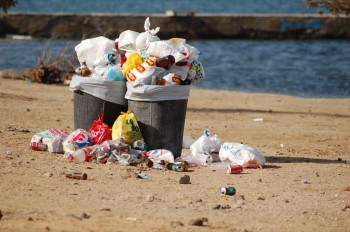
Everybody’s heard about the Pacific garbage patch. It’s the size of Texas and it’s so dense that you could build a house atop the debris. Last week I read an account by someone who sailed past the floating island and who claims to have faced a constant battering from all the rubbish hitting the hull. “The debris isn’t just on the surface,” he says, “it’s all the way down. And it’s all sizes, from a soft-drink bottle to pieces the size of a big car or truck. We saw a factory chimney sticking out of the water with some kind of boiler thing still attached below the surface.”
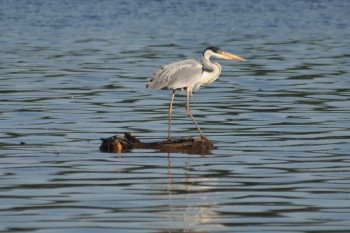
Without wishing to discredit anybody or to understate the situation, I’m not sure if I believe in this new plastic continent, complete with floating factories… but what does exist is a toxic soup which varies in consistency according to whether you’re sailing near the centre of an oceanic gyre or at an edge which is far from land. The area north of Hawaii is evidently a plastic chowder, and so too the Sargasso Sea (in the North Atlantic), but on passage between South Georgia and Cape Town you’d be skimming over a clear-water soup. Note, however, that even at this latitude and at this distance from the land you wouldn’t be voyaging through an untarnished environment. Such an environment no longer exists anywhere on this planet. There is NOWHERE you can go on this Earth where the air and the water have not been polluted by man’s industrial activities; and, on that basis, there is probably no creature whose body does not contain traces of things which shouldn’t be there – things such as dioxin and DDT.
Just think about that for a moment. In the course of just 70 years we’ve managed to poison the entire planet… and all because of our hunger for fast transport, cheap clothes, and all the other trappings of modern life.
Rubbish dumps and other dedicated waste-disposal-units excepted, the ocean is the environment which has been the hardest hit by pollution. The ocean is the planetary sump for all our terrestrial waste. All rivers lead to the sea and its erstwhile-pristine waters have been contaminated with heavy metals such as mercury, cadmium and lead; with dioxins; with DDT and other pesticides; with fertiliser, with cyanide, with nuclear waste… You name it, and if it doesn’t dissolve in seawater it’s here, in the ocean flowing past our boat.
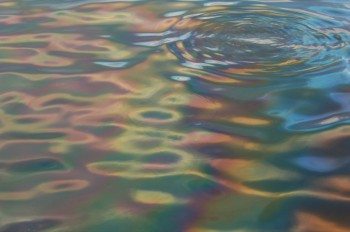
Besides the stuff which comes gushing down from the factories, the power stations, and the farmland, the ocean also has to cope with oil spilt in the course of its extraction by corporations such as BP, Shell, and Gazprom. And it has to cope with the havoc wreaked by deep-sea mining for silver, gold, copper, manganese, cobalt, and zinc. You can imagine what kind of mess that business leaves behind… especially since no one’s able to watch what’s happening.
Then there’s the pollution caused by big ships. According to something which I read recently, the transport of one tonne of cargo creates 470g of carbon-dioxide per kilometre if you carry it by air, 59g if you take it by road in a lorry, 21g by diesel-operated train, and only 10g by ship. But, believe me, those ships pump out a lot of particle-laden smoke, and those sooty smuts and sulphur and what-not are all falling back into the sea. It has been estimated that ships release close to 50 times more sulphur dioxide, per tonne of cargo carried, than lorries do.
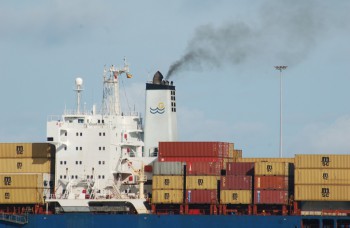
Ships also spill oil, and although they don’t all do it on the scale of the Exxon Valdez, the combined total of all the “trivial” oil spills which go unreported is probably greater by far than the mess made by that well-publicised disaster.
Ships also wash out their tanks at sea (we’ve seen ships doing this) and in some instances they even intentionally discharge wastes which they would not have been able to dump in territorial waters. In 2005 an Italian mafia syndicate was accused of deliberately sinking at least 30 ships loaded with toxic materials, including radioactive waste.
As if this wanton pollution through our effluent affluence were not sufficient, climate change is also having a disastrous effect on life in the ocean. The ocean plays a vital role in the carbon cycle, absorbing CO2 from the atmosphere and recycling carbon from organic sources (such as decaying plants and animals) and inorganic ones (such as weathered limestone rock). To use the technical jargon, the ocean sequesters carbon. When everything is in balance the thing just goes round and round, with carbon flowing in and then flowing out again, having been converted by photosynthesis and passed along the food chain. But right now, the system is not in balance.
Carbon dioxide levels in the atmosphere are now higher than they have ever been in the past 50 million years. It’s a frightening statistic, but the suitability of the atmosphere for sustaining animal life is not the only problem here; the other problem is that increased CO2 in the atmosphere leads to increased CO2 in the oceans, and this leads to oceanic acidification. According to NOAA:
The oceans have absorbed about 50% of the carbon dioxide released from the burning of fossil fuels, resulting in chemical reactions that lower ocean pH. This has caused an increase in acidity of about 30% since the start of the industrial age.
Studies have shown that this acidification has a negative effect on pretty much every marine organism – apart from jellyfish, which seem to thrive in the increased acidity. Coral reefs all over the world are dying – largely as a result of increased ocean temperatures, but also, it is thought, because of acidification. Shellfish are struggling to make their shells – because, of course, acid dissolves carbonates; and it is said that the survival of many larval marine species, including commercial fish, is also threatened.
Nor will the fishes and their kin be the only ones to suffer, for an increasingly acidic ocean is increasingly unable to operate as a vault for all that surplus CO2; so the stuff will kick around in the atmosphere instead, adding to the concentration of gases which trap the sun’s reflected rays and thus increasing global warming. Oh, and since warm water absorbs carbon less readily than cold, this is a circular thing which threatens to spiral out of control.
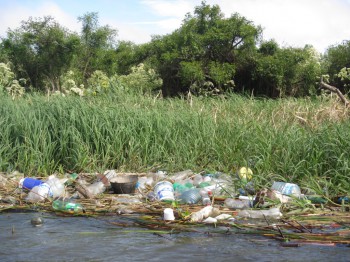
All of this bad news about global warming and toxins and so forth grabs our attention for the five minutes while we’re reading about it; and then we go and get on with life. However, if you live on the ocean or on its shores you will not be able to walk away so easily from the most visible aspect of pollution. If you live here, then every day you are confronted with the sight of plastic bottles and other crap which bobs about on the briney and fringes the beach. It has been estimated that the mass of plastic in the oceans may be as high as 150 million tonnes – and yet 60 years ago there would have been none, because the stuff didn’t exist!
Maybe you think that the oceanic garbage patches are an eyesore but nothing much more. And the plastic bags and other junk which brings death to so many marine animals…?
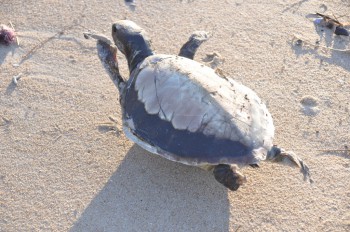
It’s a shame about the turtles. They’ve been living on the planet for a lot longer than us and nothing in the course of their evolution has prepared them for the idea that there might be things, drifting about in the ocean, which can kill when they are ingested; so they eat plastic bags, which look a lot like jellyfish when they’re floating along. And then, sadly, they die.
It’s a pity, too, about the seals and other animals which get six-pack rings and other plastic bits and pieces caught around their limbs. And it’s sad to think of all the millions of fish, and sharks, and dolphins which get caught in lost pieces of monofilament fishing net and which end their days starving or drowning in the invisible snare. (I’ve swum, slap-bang, into a monofilament net, so know how hard they are to see.)
Maybe that’s the way you think of it: it’s sad; but we’re facing other, bigger problems. This one won’t end the world; there are plenty more fish, and – well, there are not so many turtles when you think about it…
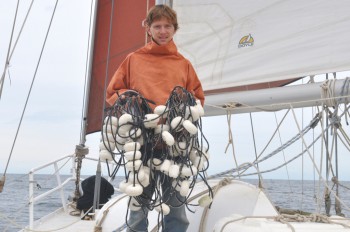
There are not so many turtles, and anyway, the problem goes a lot deeper than that. Just last week I saw a photo of a whale which had washed ashore in the Netherlands. In its stomach the scientists found 59 different plastic items. Most of the plastic consisted of that transparent polythene sheeting which is used to build greenhouses in Spain. The other items included plastic bags, plastic rope, plastic hosepipe, two flower pots, and a plastic spray canister. The cause of death was an intestinal blockage.
This whale was not unique – many other cetaceans have been found to have plastic in their stomachs (baleen whales sweep it up inadvertently when feeding on squid and fish) – and the problem is also affecting ocean-dwelling birds. It is estimated that over one million birds die each year as a result of ingesting plastic debris. Nearly all Laysan albatross have plastic in their digestive system and one-third of their chicks die.
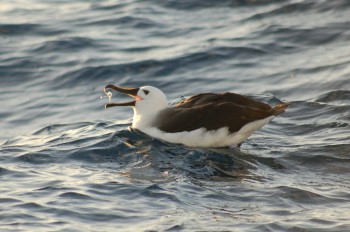
As I say, marine birds and animals didn’t evolve to cope with non-digestible matter. There is no fail-safe mechanism here; if they’re hungry and there’s something floating, they will have a go at eating it. However, even this is not the end of the story, because the plastic bags and other junk floating around on the ocean are not the only problem. Once again, it’s the stuff you can’t see that’s doing most harm.
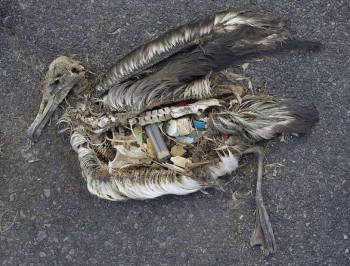
Given sufficient time and sunlight, plastic degrades. But it doesn’t go away. There is no away, on this planet. Everything that’s in the system is in it for good; it all just keeps on going round and round. Unfortunately, whereas natural materials are apt to change their form pretty quickly, degraded plastic just disintegrates into ever smaller pieces – and even when it’s down to the molecular level it’s still inedible. When floating plastic particles degrade down to the size of zooplankton, plankton-eating animals come along and gobble them up, and in this way the plastic enters the ocean food chain.
Plastic molecules are not nutritious… but even this is not the full story; it gets worse. Plastic debris doesn’t biodegrade, but it does absorb insoluble pollutants, such as petroleum oil and DDT, and this makes it even more deadly. The contaminants accumulate in fatty-tissues, so that animals higher up the food chain gradually acquire more and more of the toxins.
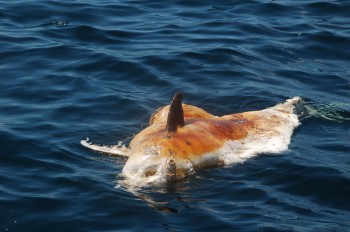
A friend who is an oceanographer tells us that 64% of albatrosses and petrels washed ashore on the coasts of southern Brazil over a period of two years had plastic particles in their stomachs. Some of these were derived from degraded water bottles and so forth, which may have been ingested in the tissues of legitimate prey, but 35% took the form of tiny polystyrene pellets (or nurdles, as they are known in the USA). These pellets look a lot like the eggs of marine organisms, and they are one of the worst offenders when it comes to soaking up oil and other toxic wastes. It has been estimated that there may be as many as 8,000 polystyrene pellets per square kilometre of ocean! Fish eat them, too. I haven’t been able to find any statistics regarding the amount of plastic found in their guts, but if you knew how much mercury fish contain you wouldn’t be eating them anyway.
There is a solution!
It’s all BAD, BAD, BAD news – but there’s some good news, too. We can do something about this problem. 70 years ago mankind didn’t have plastics; so, quite obviously, we don’t need them! There’s no doubt that plastic bags and bottles and so forth are convenient, but are we really going to swap life on earth for convenience?
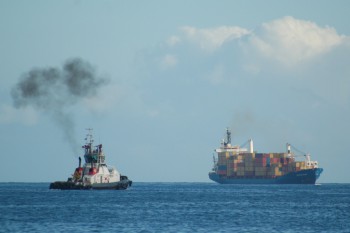
There are lots of ways that we can go about reducing our impact and walking more lightly on this fragile earth, and the time for talking about them is over. We need to get on with cutting back on our use of cars, planes, and other machines which suck up fossil fuels and spit out fumes. We need to start thinking about our purchases and stop buying things which have been shipped all the way from China; we need to buy locally-made goods – and in the case of food that means really local, ideally from your friendly neighbourhood organic farmer – the guy who isn’t filling the ocean with pesticides, herbicides, and fertilisers.
We need to turn out the lights, switch off the kettle before it boils, turn down the heater, and bin the air-conditioner. (Gran-ma managed without, so why can’t you?)
Other things to think about include improving your insulation, if you live somewhere cold; using a pressure cooker, which saves gas or electricity; and giving up meat, whose production is responsible for an estimated 18% of greenhouse gas emissions.
The population has doubled in the past 40 years, and every hour of every day another 8,000 people join us here. That’s another 192,000 potential polluters every day, and another 75 million each year with whom to share the finite and ever-dwindling resources. So, with the demands on the planet increasing exponentially, it’s worth our while to learn, right now, how to live happy fulfilling lives without access to the goodies, and in particular without the use of petroleum and its derivatives. For the sake of the ocean, for the sake of the planet as a whole, and for our own sakes – for Pete’s sakes, too, if you like! – it’s worth our while to learn, right now, how to manage our personal desire for new stuff. And this month, this week, this day would be the best possible time you could start.
Can you manage without plastic for a whole month?
This is the challenge: can you manage to get through this whole month without buying any plastic?
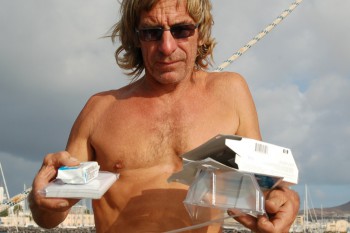
“Sure!” you say. “No plastic bags at the check-out; no polystyrene trays under the veg, and no cling-film around the broccoli – hmm… that could be a tricky one, but we’ll work something out. No disposable plastic cups and plates; no plastic toothpaste tubes or plastic shampoo bottles… (Yeah, well I’ve just bought a new bottle, luckily, so I can manage for a month!) No bottled water or soda – well, I’m not silly enough to buy that kind of junk anyway! No plastic tubs of ice-cream, no plastic pots of yoghurt, no deodorant, no sun-screen, no plastic-cased cameras and lap-tops; no plastic toys and… Hey! Wait a minute it’s Christmas…!”
Yes, it’s the silly season when we’re all accustomed to rush out and buy tons of plastic stuff, much of which will end up in the bin, in the land-fill, and sometimes in the sea. So, we’re challenging you to enjoy a totally plastic-free Christmas, with no plastic tinsel, no plastic-wrapped choccies, no plastic mistletoe (definitely none of that, please!) and no plastic presents. Not one. No, not even DVDs.
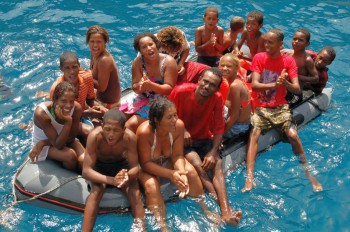
Fundamental to the philosophy of reducing our use of the world’s resources lies an attitude of voluntary simplicity. When you begin to live life in this way you discover that doing without, of your own volition, is actually a very satisfying thing! (Doing without because you can’t afford stuff or because it’s all gone is another matter altogether… which is why it’s best that we learn the art now, and make frugal living a choice and a pleasure.)
If you want to give presents and show your family and friends that you care, try to find ways of doing it without the uncaring act of buying something which has been shipped from the other side of the world; try to do it without buying something whose production involved the creation of greenhouse gases by the burning of fossil fuels, or the destruction of rainforests and wildlife in Amazonia or Borneo.
When you come to think of it, that rules out most stuff, doesn’t it…!?
Well, one way of showing your folks that you care both for them and for the world is to give home-made presents. We’ve always done this, right from the time when the kids were small. I won’t pretend that they were never given any plastic – they had lots of Lego and Playmobil, albeit most of it was second-hand – but they also had wooden boats handmade by their dad, and clothes and dolls made by Your Correspondent. As they grew older they joined in with this game. I’m proud to be able to say that, so far as I can recall, none of my kids has ever bought me a present; but they’ve made me wooden boxes and knitted me scarves, and they’ve assembled pads of hand-made paper, sewn bags and cushion-covers, cooked fudge and cookies, and made necklaces and earrings. I even have a little hand-carved Buddha, courtesy of Roxanne. When somebody takes the time to make something for you, then you know they love you!
Still, as I say, the key to cutting back on our use of plastic is not so much to find alternatives as to understand that possessions are not the key to happiness. The truth of the matter is that possessions are a burden. We have to struggle to get them, then we struggle to keep them (whether from being stolen or being damaged), and then we get upset when we lose them (these days, generally, to that thief known as built-in obsolescence).
I think that the happiest, most fulfilled person I’ve ever met – and certainly the wisest and the most awesome – was a Buddhist monk living at a monastery in England. He owned his robes and a bowl, and nothing else!
And one of the things that I remember most vividly about our shipwreck in the Southern Ocean is the freedom which I felt on stepping ashore in the Falklands with absolutely nothing. We had just lost everything that we owned in the world (or so it appeared) and yet there was no sense of being bereft; rather there was a huge sense of relief; all our burdens had been taken from us! When the boat was recovered I even felt a tinge of disappointment. 18 years on, we’ve picked up even more crap to lug along the road of life… When will we ever learn!
For advice about plastic free living read Beth Terry’s website and her book. You can even buy it as an e-book, so if you’ve already invested in one of those plastic e-book readers it needn’t cost the Earth any more pain and hardship.
Another good read, and another ideal gift is The Story of Stuff. If I haven’t managed to explain the damage that we’re doing to the planet and talk you out of buying things, this should do it!
The final word on this subject is mindfulness. If you pay attention to what you’re buying, and you really think about how it was made, where it came from, and whether you need it more than you need a safe planet for your kids, then you’ll find that you buy a lot less stuff. And that has to be a good thing, for everybody except the greedy manufacturers.
Wishing everybody a fantastic plastic-free Christmas and a low-consumption new year.
If you accept the challenge of a month without plastic, let us know how you get on, please. And if you’d like to help in the important process of getting everybody else on board, so that we all unite to tackle the issue of marine pollution, please share this article on Facebook or e-mail it to your friends.

Jill Dickin Schinas:
I do like your phrase, “inferno combustion engine.” I stopped to think about it and I started laughing. I was at the pump in a gasoline station and your phrase comes to mind. It costs about $80.00 USD to fill a Chevrolet Camaro sports coup. We do not live in a safe enough neighborhood to not use a car. We could not afford a Chevrolet Volt. The Volt is the way to go, that it uses less gasoline, oil or alcohol. Alcohol has made maze and corn farmers wealthy, but has made food prices so high that people became poorer in the population. I am the only one in my house hold that rides recumbent bicycle. Recumbent bicycle is not cheap, around $700.00 to $2800.00 USD. Bicycling takes care of my transportation 10%. I face risks like falling, getting robbed; bike jacked (different than pirates at sea, but same risks, or run over by a car or another bicycle.
The air is not clean with all of these inferno combustion engines like you mentioned. The climate is changed to drier weather. California is in a drought, but not known if global warming causes it, maybe it is just a natural cycle or dry years.
The U.S.A.’s economy depends upon mass consumerism. It depends upon inexpensive fuel. Stockton is totally dependent upon commuting for jobs far away. I face that dilemma, as I did not have a steady job for the last 5 years, since the market collapsed. If I can afford it, then I would not mind to sign up to ride in a sail boat and meet at a harbor some where with my pass port and some income saved to cover expenses. Yes, there are risks in traveling in a small vessel. I would try to apply for Google Earth, small shop some where, but where, and the stereo repair and LED lights driver circuits are limited pocket change income. I have even thought about importing compound microscopes from BW Optics, Nanjing, China by Cai Song. The prospects of selling a microscope is not easy as it is saturated in North America.
I still find it entertaining at the gasoline station; “inferno combustion engine.” I cannot afford to drive, but I refuel my mom’s car, while I ride a recumbent bicycle to try to stay fit and lose weight and not get my arteries and vessel clogged with fat.
Lawsen Lew